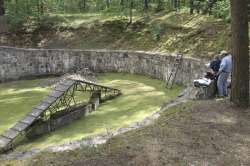Researchers discover escape tunnel used by Jewish prisoners to escape Nazi captors
Vilnius: A group of researchers have discovered the location of a tunnel that was dug with spoons by Jewish prisoners to escape their Nazi captors during the second world war. According to researchers – a

Vilnius: A group of researchers have discovered the location of a tunnel that was dug with spoons by Jewish prisoners to escape their Nazi captors during the second world war.
According to researchers – a team of archaeologists, geophysicists and Jewish historians from Israel, the US, Canada and Lithuania, this tunnel was dug in 1944 by prisoners in the Ponar forest, known today as Paneriai, outside the Lithuanian capital, Vilnius.
Here an estimated 100,000 people had been killed since 1941, including 70,000 Jewsm who were were ripped and thrown into pits during Nazi occupation, said researchers.
For getting the map of the path of the 34-metre (112ft) tunnel. , researchers used scanning technology called electrical resistivity tomography, also used in mineral and oil exploration.
“To find a little glimmer of hope within the dark hole of Ponar is very important as humans,” said Jon Seligman, an archaeologist with Israel’s antiquities authority, who participated in the expedition.
“The tunnel shows that even when the time was so black, there was yearning for life within that.”
Toward the end of the war the Nazis sought to erase the evidence of their mass killings. Jewish and Soviet prisoners were brought to the Ponar forest from Stutthof concentration camp. With their legs chained, they were forced to dig up the mass graves, collect bodies and burn them.
The prisoners were dubbed the Burning Brigade, and they lived in fear that once their task was complete, they too would be killed.
According to the report, one prisoner, Isaac Dogim, was piling decomposed corpses when he recognised members of his own family including his wife, whom he identified by the medallion he had given her for their wedding. He is credited with organising the escape.
At night the prisoners were held in one of the pits used in the killings. For three months some of the prisoners secretly dug an underground tunnel to escape. Then on 15 April 1944, in the middle of the night, 40 prisoners filed off their chains and fled.
Guards quickly discovered them and many were shot, but 11 prisoners managed to escape to the forest, reach partisan forces and survive the war.
“It is a very important discovery, because this is another proof of resistance of those who were about to die,” said Markas Zingeris, director of the Vilna Gaon Jewish State Museum in Vilnius.
A Lithuanian archaeologist discovered the tunnel entrance in 2004, and the museum called on the research team to search for the entire tunnel. The team traced the length of the tunnel and found the tunnel exit. Their quest is the subject of a forthcoming documentary by the science series Nova, premiering in the US next year.
Same research was done last year by using the ground-penetrating radar to discover parts of the old Great Synagogue of Vilna, which was demolished by Soviet authorities after the war. To find out about the life history of Jewish life in Vilnius, researchers are now excavating the site.
“There were 500 years of creativity, a vibrant community,” said Seligman, referring to Jewish history in Lithuania. “We can’t just look at the Holocaust.”
(With AP inputs)